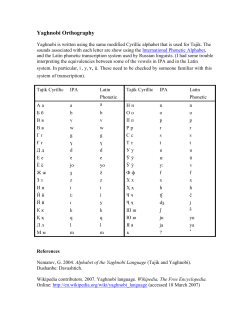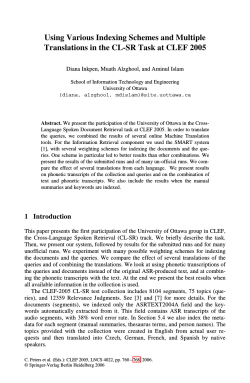
Technological Determinism of Marshall McLuhan From Chapter 26 in Em Griffin,
Technological Determinism of Marshall McLuhan From Chapter 26 in Em Griffin, A First Look at Communication Theory, 1994 CLICKER MCLUHAN WAS EARLY TO RECOGNIZE THAT WE WERE ENTERING THE AGE OF PRINT; A = TRUE B = FALSE CLICKER MCLUHAN WOULD SAY: A = Inventions in communication technology cause cultural change; B = The age of print had its obituary tapped out by the telegraph; C = The electronic media are retribalizing the human race; D = Instant communication has returned us to a prealphabetic oral tradition; E = ALL OF THE ABOVE McLuhan was early to recognize that: We were entering the Electronic Age Electronic Media radically alter the way people – think – feel – act Historical Epoch Tribal Age Literate Age Print Age Electronic Age Technological Development Phonetic alphabet 2000 B.C. Printing Press 1450 Telegraph 1850 Dominant Sense Receptors According to McLuhan, the crucial inventions were: The phonetic alphabet The printing press The telegraph WHY THESE 3 PARTICULAR INVENTIONS? Core Concepts Inventions in communication technology cause cultural change Changes in modes of communication shape human life Channels of communication are the primary cause of cultural change “We shape our tools and they in turn shape us” Each new media innovation is an extension of some human faculty The book is an extension of the eye The wheel is an extension of the foot Clothing is an extension of the skin Electronic circuitry is an extension of the central nervous system Media are anything that amplify or intensify a bodily organ, sense, or function Media (NOT ONLY) extend our reach increase our efficiency Media (ALSO) act as a filter to organize and interpret our social existence The way we live is largely a function of the way we process information The phonetic alphabet, the printing press, and the telegraph changed the way people thought about themselves and their world “The medium is the message” The same words spoken face-to-face, printed on paper, or presented on television provide three different messages McLuhan Web Site McLuhan Web Site The primary channel of communication changes the way we perceive the world The dominant medium of any age dominates people A Media Analysis of History The Tribal Age an acoustic place where the senses of hearing, touch, taste, & smell were most developed “Primitive” people led richer and more complex lives than their literate descendants because the ear, unlike the eye, is unable to select the stimuli it takes in The spoken word is more emotionally laden than the written The Age of Literacy The phonetic alphabet put sight at the head of the hierarchy of senses: with reading people exchanged an ear for an eye Literacy (reading) jarred people out of collective tribal involvement into “civilized” private detachment The phonetic alphabet established the line as the organizing principle The Print Age If the phonetic alphabet made visual dependence possible, the printing press made it widespread Repeatability is the most important characteristic of movable type The print revolution demonstrated mass production of identical products--it was the forerunner of the industrial revolution It created the book that people could read in privacy and in isolation The printed book glorifies individualism The Electronic Age: The Global Village “The age of print had its obituary tapped out by the telegraph” The electronic media are retribalizing the human race Instant communication has returned us to a prealphabetic oral tradition where sound and touch are more important than sight All of us as members of a global village Hot & Cool Media Hot media are beamed at a single sense receptor Print is a hot, visual medium Photographs are a hot, visual medium Motion Pictures are a hot, visual medium They package lots of information in a way that requires little work on the part of the viewer Cool Media Cool media require high participation to fill in the blanks A lecture is hot Discussions are cool McLuhan-esque Examples Education People living in the midst of innovation often cling to what was, as opposed to what is Education is a prime example of a battle ground over forms of literacy--video as an audio/video aid as opposed to the primary tool The acoustic media are a threat to an educational establishment that has a vested interest in books QuickTime™ and a Animation decompressor are needed to see this picture.
© Copyright 2025













